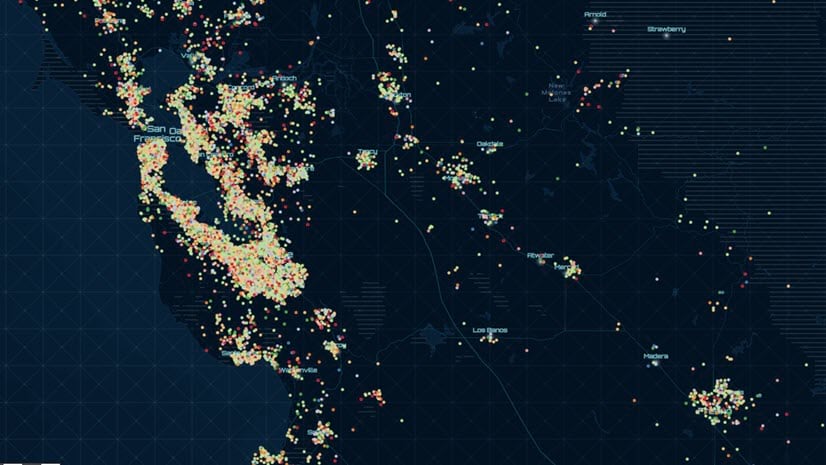A map is just another way to visualize your data like a chart or graph, right? This is what I thought 4 years ago.
The “ah-ha” moment for me was seeing how organizations were using maps to solve some of their toughest problems. For example, conserving wild life, tracking assets to improve efficiency, assessing risk during a disaster, identifying the best location for a new business, understanding customer behavior and shopping habits, and the list goes on.
These organizations, both private and public, saw the impact location had on their decisions and prompted them to dive deeper than face value. They were asking questions of their data that gave them greater understanding of the situation. They found out, “what”, “where”, “how”, “when”, and “why” all from location data.
Map visualization vs. location analytics
A map visualization, often displayed within traditional analytics and business intelligence platforms, communicates what’s going on where. While informative, these visualizations simply locate where and when events have occurred – they are descriptive. However, how many times has someone comeback to you with questions that require you to go beyond the dashboard – Why are sales down? Why does this store have fewer customers? Why is this happening? Why? Why? Why? You would use various analysis techniques to find the answer, with results often displayed in charts and graphs. But, what if I told you answers to these questions can also be found using location, even questions you didn’t know to ask.
Location analytics is the process of exposing the unseen through the analytical lens of “where.” It goes deeper than map visualizations by making sense of patterns, trends, and relationships found in location information. It uses both location and business data together to answer questions, predict, and uncover insights often overlooked in tables and charts alone. Location analytics makes it possible for anyone to understand complex analysis and do their own queries to gain spatial insights. The outcome of location analytics gives organizations intelligence to optimize actions, decisions, and customer experiences.
Analyze all dimensions of your data
When searching for answers in your data, you wouldn’t overlook the temporal (time), qualitative (categories) or quantitative (numbers) attributes of your data, so why leave out spatial (location)? Let’s take a look at an example.
In this retail analysis, Helen Thompson, global marketing strategy manager for real estate, banking, and insurance at Esri, examines customers and shopping behaviors within Santa Clara, California. Her analysis starts with a 10-minute drive-time around each of her stores. Looking closely at the map visualization she created, she finds that a store on Tully Road has fewer customers than other stores. This descriptive observation can be made with BI tools; however, where they fall short is answering “why”. Why does Tully Road have fewer customers? To answer the question completely, location must be analyzed. Let me show you why…
Thompson breaks down this question by first filtering her customers by the 10-minute drive-time around Tully Road (a location analytic operation called a spatial filter). Then she adds on a layer of Esri Tapestry Segmentation. This out-of-the-box data describes US neighborhoods by their lifestyle choices, what they buy, and how they spend their free time. As a result, Thompson uncovers cross-shopping as the cause of fewer customers.
By pairing location analytics with a simple a pivot table, Thompson sees where Tully Road customers are coming from in a matter of minutes. Surprisingly, they are outside the 10-minute drive-time.
The importance of location analytics
Without location analytics, these insights would have been overlooked. Why? In a table or graph, the locations of these customers are just numbers and words. Seeing data this way makes it almost impossible to quickly expose this type of connection. With location analytics, we uncover patterns, trends, and relationships that can only be seen by examining our data in relation to the real-world. No other type of analysis can do this.
With Insights for ArcGIS, analyses like the above are as easy as a drag-and-drop operation. Rather than preparing your data to ascertain these kinds of insights or having to look at datasets independently, you get the entire picture in one view. This allows you to focus your analysis and take your questions even deeper. And the great thing is, you don’t have to do anything more to your data to get this level of granularity. For instance, give your data geographic roles or create a schema file to recognize spatial information like latitude and longitude. Insights for ArcGIS does this right out-of-the-box.
With location analytics, uncover patterns, trends, and relationships that can only be seen by examining data in relation to the real-world. No other type of analysis can do this.
Go deeper, get granular
We can take Thompson’s analysis even further. Since we know cross-shopping is a reason why Tully Road has fewer customers, our next question might be, “why are those that live closest to Tully Road going to other stores?” And, “why are those that live further away, driving to Tully Road?” Both questions can be answered using location analytics.
To get the answer, we need to know more about the people that live in these areas. Knowing about our customers at a city level isn’t granular enough. Why? Demographics and lifestyles vary greatly from city to city.
If we look at the dashboard again, we can see that Tully Road customers are not only coming from different cities, they’re coming from various neighborhoods. The great thing about Thompson’s analysis is that she has already joined her customers with Esri Tapestry Segmentation data, giving us more insights about the types of people shopping at Tully Road. The top five tapestry segments in this analysis categorize customers as Metro Renters, Savvy Suburbanites, Professional Pride, Green Acres, and Rooted Rural. With this information, we can explore things a bit more to determine if we need to rethink how we merchandise or target a marketing campaign.
In summary
To be truly informed, it’s not always about what you see at face value. Just as an iceberg appears small at sea level, you must dive beneath the surface to see its true mass. The same goes for location data. It is beyond the map visualization where you expose the unseen and drive real action.
Ready to go beyond map visualizations? Give location analytics a try. Sign up for a free 21-day trial to Insights for ArcGIS.
See how organizations are using location analytics to, conserve wild life, track assets to improve efficiency, assess risk during a disaster, identify the best location for a new business, understand customer behavior and shopping habits, and more.
Attending the TDWI conference in San Diego? Meet with Esri to explore location analytics for your organization.


Commenting is not enabled for this article.